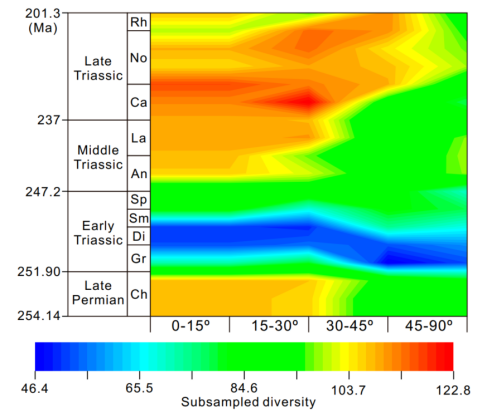Biodiversity is not evenly distributed around the world. Most species live in the tropics, and few species live in the Arctic and Antarctic. But the fossil record reveals a completely different pattern between 252 and 247 million years ago.
In a new study published in the Proceedings of the National Academy of Sciences, Prof. SONG Haijun et al. examined 52,000 fossils of marine organisms from the late Permian to Triassic period. They described a more uniform distribution of biodiversity due to severe environmental changes during that period, coupled with a severe mass extinction event. There were roughly the same number of species from the tropics to the poles—the latitudinal diversity gradient was almost flat.

Global distribution of biodiversity during the late Perm to Middle Triassic
Song and his colleagues propose a concept for what could have evened out the field of global biodiversity—the severe global environmental conditions during the Early Triassic. The conditions featured an ocean warm-up by 10 °C and adeficiency of oxygen in the world’s oceans, which resulted in the fall of tropical ecosystems. Moreover, the fossil record reveals that biodiversity turned more uniformly distributed since species that withstood the mass extinction became widespread, and the severe environmental condition inhibited the accumulation of endemic species such as present tropical biota.

Diversity trend during the Permian-Triassic
Overall, the fossil record suggests that environmental stability is critical for retaining a rich tropical marine fauna while drastic climate changes might specifically harm tropical ecosystems.
Reference:Song, H.*, Huang, S., Jia, E., Dai, X., Wignall,P.B., and Dunhill,A.M., 2020.Flat latitudinal diversity gradient caused by the Permian–Triassic mass extinction. PNAS, www.pnas.org/cgi/doi/10.1073/pnas.1918953117.